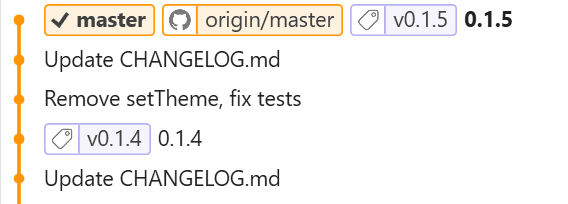During last year's Hacktoberfest, I decided to make a small, achievable extension for VS Code. It was a good way to learn TypeScript, work with people on Github projects, and most importantly: have fun!
The extension is called Light Switch — It is a time based, light/dark theme switcher. When I published my first series of commits to get started, I also wrote a post about it on DEV. I was sure this would help me get traction and a small following of people that would hopefully be willing to contribute in one way or another:

Hacktoberfest: Let's build a VS Code Extension
Juan Alejandro Morais ・ Oct 16 '19 ・ 2 min read
The post was well-received, and it got the traction I wanted. Once the rush came down, I still needed to figure out how to:
- Create tests.
- Bundle the extension.
- Publish the extension.
- Set up a Continuous Integration (CI) pipline.
Here's how I achieved it.
Writing tests 📝
If you're writing software, writing tests is an awesome way to ensure it will work. Since I did not have much time or experience with TypeScript, I made sure to focus my tests on the theme swapping logic:
- Make sure the themes stay as day/night according to their times
- Ensure a default "fallback" theme could be chosen if there was an error
Since my logic mainly involves time, I focused on time conversions. This is an example of the tests I added:
import * as assert from 'assert';
import * as dayjs from 'dayjs';
import { canSwitchToNightTheme } from '../../util/date';
suite('Date Test Suite', () => {
test('Setting time through the extension', () => {
assert(!canSwitchToNightTheme('17:00', '16:00'));
assert(canSwitchToNightTheme('17:00', '17:00'));
assert(canSwitchToNightTheme('17:00', '17:01'));
assert(!canSwitchToNightTheme('17:00', '00:00'));
assert(canSwitchToNightTheme('17:00', '24:00'));
assert(canSwitchToNightTheme('17:00', '23:59'));
});
});
Basic assertions, check!
Bundling the extension! 🚀
I'm sure many of you have a love/hate relationship with webpack. Yes, it's great, and also painful. Luckily, Microsoft has excellent documentation on how to bundle a VS Code extension - yay!
Handling dependencies
1. npm uninstall vscode
2. npm i --save-dev webpack webpack-cli ts-loader vscode-test
3. npm i --save-dev @types/vscode@1.37.0
- Remove the
vscodedependency, as it has been superseded byvscode-test— This will ensure your tests run on the Azure DevOps pipeline. - Installed the required basic dependencies
- Added
@types/vscode@^1.37.0. Depending on the version of your vscode engine, you will have to specify it as@types/vscode@ENGINE_VERSION. - Removed the
postinstallscript ofpackage.json. It is not needed anymore.
Creating the Webpack configuration
With this configuration, builds will be (by default) output into the dist/ folder at the root of the project. Nothing too fancy here!
//@ts-check
'use strict';
const path = require('path');
/**@type {import('webpack').Configuration}*/
const config = {
target: 'node',
entry: './src/extension.ts',
output: {
path: path.resolve(__dirname, 'dist'),
filename: 'extension.js',
libraryTarget: 'commonjs2',
devtoolModuleFilenameTemplate: '../[resource-path]'
},
devtool: 'source-map',
externals: {
vscode: 'commonjs vscode'
},
resolve: {
extensions: ['.ts', '.js']
},
module: {
rules: [
{
test: /\.ts$/,
exclude: /node_modules/,
use: [
{
loader: 'ts-loader'
}
]
}
]
}
};
module.exports = config;
Adjusting the extension configuration files
package.json
I added a step called test-compile so it can compile our source for tests (Read why on the next section)
"scripts": {
"vscode:prepublish": "webpack --mode production",
"compile": "webpack --mode production && npm run test-compile",
"watch": "webpack --mode development && tsc -watch -p ./",
"test": "node ./out/test/runTest.js",
"test-compile": "tsc -p ./",
}
launch.json
Even though the webpack build points to the dist/ folder, tests are compiled to the out/ folder, which means we have to compile the app (Refer to the test-compile command of package.json. Luckily, this can be specified on the preLaunchTask, so I made sure it ran test-compile.
"configurations": [
{
"name": "Run Extension",
...
"outFiles": ["${workspaceFolder}/dist/**/*.js"],
"preLaunchTask": "npm: watch"
},
{
"name": "Extension Tests",
...
"outFiles": ["${workspaceFolder}/out/test/**/*.js"],
"preLaunchTask": "npm: test-compile"
}
]
.vscodeignore
Getting this one right was a bit difficult, here's why:
You have to exclude node_modules. The caveat: If you have a dependency (not devDependency), you will have to include it. I had moment as a dependency, but was able to swap it for dayjs, even as a devDependency. Woosh!
As a general rule, ignore everything that is not the source of the app (including icons/images your app uses).
# folders
.vscode/**
.vscode-test/**
src
out
node_modules
**/tsconfig.json
**/tslint.json
**/*.map
**/*.ts
*.vsix
# Specific files
.gitignore
webpack.config.js
CONTRIBUTING.md
package-lock.json
.prettierrc
# Special exclusions
images
!images/icon.png
Making sure it runs!
- I had to make sure my builds were compiling. By running
npm run compileandnpm run test-compile, they succeeded!
Publishing the extension ☁️
The only dependency I needed was a global one: npm install -g vsce. vsce is a CLI for managing VS Code extensions.
Interestingly, this was the easiest part. I had to create an Azure DevOps organization, and I followed every step of this tutorial.
When creating the marketplace publisher, I was prompted for my Personal Access Token, which I generated following these steps.
My strategy for publishing would be:
- Publish it first using
vsce publishso the app was live - Set-up a Continuous Integration environment to automate the following deploys.
Making sure it runs!
The cool thing of all this, you can install your builds locally! This is different to debugging your build directly from the Launch menu because it emulates the flow of downloading the build directly from the marketplace.
The command vsce package triggers the vscode:prepublish script from package.json configuration. A .vsix file will be created at the root directory. Install the extension by running code --install-extension extension-name.vsix. Replace extension-name for the file generated by vsce package, i.e. light-switch-0.1.0.vsix.
Continuous Integration (CI) 🛠
Once my extension was live, I had to implement the most important part: a CI pipeline. This is a great DevOps practice, as it automates all your builds, and runs your tests on new changes - This ensures new code won't break the app before being able to merge it into the master branch.
You can have a look at my pipeline build summary.
Here are some key takeaways I learned:
- Before setting up any CI pipeline, make sure your app works locally, and that every command behaves as intended.
- You don't have to know how to use YAML files to set up a working pipeline. Microsoft offers many templates to get started with.
- Azure DevOps allows you to build and deploy without having to create any artifacts/releases - This is awesome, and it saves a lot of time!
Setup
azure-pipelines.yml
# Builds from every branch, and tag.
trigger:
branches:
include: ['*']
tags:
include: ['*']
# Machines that it builds to
strategy:
matrix:
linux:
imageName: 'ubuntu-16.04'
mac:
imageName: 'macos-10.13'
windows:
imageName: 'vs2017-win2016'
# Takes in the machines specified in the strategy.
pool:
vmImage: $(imageName)
steps:
# Installs Node.js
- task: NodeTool@0
inputs:
versionSpec: '8.x'
displayName: 'Install Node.js'
# Installs an X virtual framebuffer (https://en.wikipedia.org/wiki/Xvfb).
# Only required for running the VS Code in the Linux machine.
- bash: |
/usr/bin/Xvfb :99 -screen 0 1024x768x24 > /dev/null 2>&1 &
echo ">>> Started xvfb"
displayName: Start xvfb
condition: and(succeeded(), eq(variables['Agent.OS'], 'Linux'))
# Run yarn (Install dependencies) and run the compile script.
# It also runs the tests and stops the pipeline if one test fails.
- bash: |
echo ">>> Compile vscode-test"
yarn && yarn compile
echo ">>> Run integration test"
yarn && yarn compile && yarn test
displayName: Run Tests
env:
DISPLAY: ':99.0'
# Publishes the extension to the marketplace.
- bash: |
echo ">>> Publish"
yarn deploy -p $(VSCODE_MARKETPLACE_TOKEN)
displayName: Publish
condition: and(succeeded(), startsWith(variables['Build.SourceBranch'], 'refs/tags/'), eq(variables['Agent.OS'], 'Linux'))
And here we have it!
The last build had an error while building with Windows, but it was able to deploy the latest changes using the Linux image. See the build output.
Notes
A YAML configuration can run as many commands as you want. Think of every - bash: | entry as a set of new commands that will run in a specified batch. It can execute bash commands i.e. ls, pwd, echo, etc.
The last step, which publishes the extension, passes in a $(VSCODE_MARKETPLACE_TOKEN) variable. This is the Personal Access Token (PAT) we defined earlier on the Publishing section. If my variable was named secret, then the script would run yarn deploy -p $(secret).
The last build step has a condition: and(succeeded(), startsWith(variables['Build.SourceBranch'], 'refs/tags/'), eq(variables['Agent.OS'], 'Linux')). This conditrion tells our pipeline to deploy with builds that meet the following requirements:
- The building machine's OS is Linux (In my case: Ubuntu 16.04).
- The commit has a git tag.
- I solved my tagging by using Semantic Versioning via
npm versioncommand, i.e.npm version major/minor/patch. This is convenient because it updates thepackage.jsonversion, and makes a commit with a tag:
- I solved my tagging by using Semantic Versioning via
It's a wrap! 🌯
The entire process did not take long, but figuring out the CI pipeline was the most complex part by far. Thanks to Microsoft's well-written documentation, I was able to put the pieces together.
Check out the official guide.
Share your thoughts!
Have you published a VS Code extension? If so, how was your process? I'd love to learn about your experience!
Photo by Pierre Châtel-Innocenti on Unsplash.









Top comments (0)